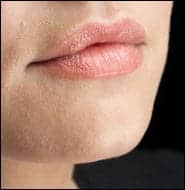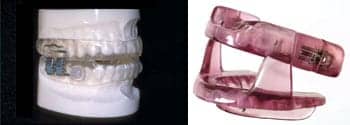 |
To plug in or not to plug in? That is the question sleep physicians can now pose to patients with mild to moderate OSA. Under the guidelines of the American Academy of Sleep Medicine (AASM) 2005 practice parameters, sleep physicians can now offer mild to moderate OSA patients oral appliance (OA) therapy in lieu of CPAP or surgery. While the first generation of OAs were large, minimally adjustable bite plates similar to athletic mouth guards, the latest generation is smaller, more comfortable, less visible, and incrementally adjustable. Certain OAs also can be directly attached to CPAP machines to allow for positive airway pressure therapy. For mild to moderate OSA patients who would rather bite down than plug in every night, OAs’ latest—and future—designs may be an attractive choice.
Two Basic Types of OAs for Sleep
There are currently two basic types of oral appliances for OSA. Mandibular repositioning appliances (MRAs, sometimes known as mandibular advancement appliances) are most often recommended by dental professionals experienced with OA therapy. MRAs typically use two bite plates, or “splints,” that are custom molded to the patient’s upper and lower teeth. The splints are then locked together with a type of hinge that is fastened to the sides or back of the appliance. Once inserted into the mouth and attached to the patient’s teeth, the MRA uses the upper jaw as an anchor to extend or “protrude” the mandible, or lower jaw, forward. This clears the airway by tightening the excess tissue in the back of the throat, preventing the tissue from collapsing and blocking the airway while the patient’s mouth is closed.
Higher-quality MRAs can be adjusted or “titrated” with mechanisms that can shift the lower jaw forward or backward in microincrements. Many premium OAs also can vertically adjust the opening between the upper and lower splints, as well as account for side-to-side movement for patients who grind or clench their teeth, known as “bruxing.” In short, the idea behind the MRA type of appliance is to push the lower jaw forward and up, while the patient’s tendency is to drop it down and up during sleep and thereby block the airway.
The second type of OA is called a tongue-retaining (TR) device. TRs comprise two fused splints with an elastic sleeve or bulb sandwiched between them. The patient inserts his or her tongue into the sleeve, which holds the tongue in the forward position and prevents it from blocking the throat and air passage. TRs can be quite effective, but they can also be uncomfortable because their tongue-forward design forces patients to breathe through the nose and prevents talking or drinking. Not surprisingly, some patients also complain that TRs are unattractive to bed partners. Consequently, MRAs have flourished and dominated the OA field, but dentists still recommend TRs for patients who wear dentures or have few natural teeth. Strongly implanted teeth are important because MRAs use the teeth to anchor the two splints to the jaw and push the lower jaw forward; therefore, cemented dentures or bare gums are too weak to hold the appliance in the mouth.
OAs may be categorized as either short-term or long-term appliances. The long-term devices are customizable, adjustable, and generally more durable. Short-term appliances are sometimes referred to as “boil and bite” because dentists fit the appliance to the patient’s teeth by inserting it into hot water, temporarily softening the plastic. The patient then bites into the appliance, molding it to the person’s dentition.
There are several advantages to boil and bite appliances. First, only one dental visit is needed to fit the appliance to the patient. Long-term appliances may take two or three visits to adjust the titration as well as account for other dental issues, such as bruxing and impinging on dental work. Second, boil and bites are less expensive than long-term appliances. Some patients therefore may use boil and bite appliances first to test their comfort with OA therapy before purchasing the more costly customized products.
The disadvantages of boil and bites are that they are less adjustable and durable than long-term appliances. They can last as little as a day or as long as a year. Their lack of adjustability and customization may cause muscle soreness by forcing the lower jaw to be extended more than is needed. Boil and bites are also larger, can stain, and may retain an odor.
Dentists who fill prescriptions for OAs have their preferred brands, but they also often choose the device based not only on their effectiveness but also for the specific dental requirements of each patient.
“You want a dental professional to be treating this because there could be other issues such as TMJ [temporomandibular joint disorder] that you’d want to diagnose and intercept and document before you start repositioning the jaw during a night of sleep,” says Laura Sheppard, a certified dental technician for Minneapolis-based Dental Services Group, the manufacturer of the Adjustable PM Positioner.
She adds that a high-quality OA should be customizable to the patient, and, most importantly, the protrusion mechanism should be adjustable. “Some patients need only 2 mm of protrusion, and other patients need 7 mm,” she says. “The average is 50% to 70% protrusive ability in an appliance, and that is where the patient is most effective.”
While any dentist can fill a prescription for an OA and then consult with a dental laboratory about the correct protocols, manufacturers advise patients to go to dentists who are members of the American Academy of Dental Sleep Medicine (AADSM). AADSM dentists are certified in dental sleep medicine and have taken courses and worked on a certain number of cases for certification. Many have affiliated themselves with sleep centers and work with mild to moderate OSA patients.
 |
| Oral appliances come in several varieties. The Adjustable PM Positioner from Dental Services Group (left) and the SomnoMed MAS™ are just two examples. |
Keith Thornton, DDS, the inventor and owner of the TAP brand of oral appliances, has worked with sleep laboratories and often uses home monitors to objectively measure the effect of titrating the appliances. He also works with the patient’s primary care physician or referring sleep physician. He says that he treats many patients who have failed CPAP and that he also sees referrals from primary care physicians, cardiologists, and internists.
Sheppard also notes that patients often self-refer on the basis of information they get from the Internet or on the advice of friends. While some dentists encourage their patients to go to a sleep laboratory for diagnosis, patients who do not have insurance coverage for either the sleep study or the OA may not do so for financial reasons. As a result, dentists may still construct OAs for patients who self-refer, but because the OSA has not been clinically diagnosed, dentists cannot guarantee that an OA will be effective, especially for more severe OSA.
Filling the prescription
When choosing an OA, experienced dentists will take into account whether the person is a mouth breather or a nose breather or both, plus other dental factors. The dentist then recommends the best appliance for that particular case.
Once the chosen appliance is returned from the dental laboratory, the dentist initially titrates the appliance’s mandible splint forward or backward until the airway is clear and the patient is comfortable. Dentists also adjust the OA so that it addresses all non-OSA dental concerns. Some dentists use home testing devices to objectively measure the OA’s effect.
Most premium OAs can be titrated in millimeter increments or even less. These titrating mechanisms enable not only the clinicians, but also the patients to self-titrate, adjusting the appliance based on subjective observations and comfort. Adjustments may be made with a small screwdriver or a tool that is provided with the OA.
However, the AASM 2005 practice parameters recommend patients return to the sleep laboratory for adjustments and confirmation that the OA is working effectively. Sheppard strongly recommends this provision to her patients.
The result of patients titrating themselves is usually a less than ideal adjustment. “They’re comfortable and getting a good night’s sleep, and the spouse says, ‘Yes, everything’s wonderful,’ and then they stop,” Sheppard explains. Consequently, while the patient’s snoring or other OSA symptoms may appear to be addressed, the OA may not be functioning optimally without some kind of objective measurement.
Patients and dentists also are attracted to the ability of modern OAs to be vertically adjusted. In the case of the SomnoMed MAS system, the upper and lower splints are unattached, allowing greater flexibility for drinking and speaking. Airway Management Inc also will be introducing the TAP III, which will be smaller and allow greater vertical flexibility. Vertical freedom may be helpful for comfort and for clearing the air passage, but may not be recommended for patients whose oral architecture requires a narrower opening to achieve a clear airway.
Modern features
The overall size of OAs has shrunk over the years. Customized OAs are generally small enough to be hidden completely under the lips, making them less visually distracting to patients. The APM Ultra, the latest generation of the Adjustable PM Positioner, has smaller screws and a smaller overall size with shorter periphery and increased tongue space.
As device comfort is also a factor, many companies now offer softer linings for their devices. For example, the TAP line of OAs offers its TL triple laminate lining, an inner laminate that is molded to the patient’s dentition and has a soft, rubbery feel. SomnoMed and Dental Services Group have their own laminate versions. However, softer materials can shorten the life of the OA compared to the harder, thicker, acrylic versions.
Lateral excursion, or the jaw’s ability to move side to side, is also a desired feature as it allows more natural movement of the jaw, and may be a great benefit for teeth clenchers and patients with TMJ.
Future OAs will most likely continue to depend largely on the dentist-inventors who pioneered the therapy. Most recently, there are some OAs that can be attached to a CPAP device. These OAs are used for patients with severe OSA who are maxed out on their CPAP pressure and can benefit from the airway being further cleared by bringing the mandible forward.
Sheppard predicts that the future will bring streamlined designs and more durable materials. She also sees the possibility of dental implants replacing much of the OA’s current infrastructure. Rather than relying on the teeth for anchorage with plastic splints, devices implanted into the jaw would serve as anchorage and retention for holding the lower jaw in proper position to the upper jaw, while advancing the mandible and tongue for a more open airway.
Whatever the advancements in OAs, their use in OSA therapy appears to be growing. For Dental Services Group’s Adjustable PM Positioner, Sheppard says, “In 1995, we made approximately 25 appliances per month. In 2000, we fabricated approximately 75 appliances per month, a 300% increase in 5 years. In 2005, we fabricated approximately 200 per month, a 275% increase in 5 years.” Lauralee Gunby, president and COO of Airway Management Inc, says her company has had similar growth. She estimates that it had been selling 400 to 500 appliances per month 3 years ago. That volume now averages between 1,000 and 1,500 per month.
Tor Valenza is a staff writer for Sleep Review. Contact him at .



